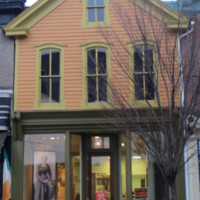
Harriet Tubman Museum
The Harriet Tubman Museum is a small museum located in Cambridge, Maryland, a few miles from where Harriet Tubman was born. The museum originated as a community organization which was planning a single three-day event honouring Harriet Tubman in 1983. Over the years, the Harriet Tubman Organisation has adjusted its goals; today its mission 'is to develop programs and services for children and families and to preserve the history and memory of Harriet Tubman by offering the general public an interpretive history of her achievements.'
The museum's permanent exhibition is a combination of interpretive text and artefacts, many recovered from nearby plantations. The artefacts on display represent the objects that the enslaved would have used in their daily lives, as well as more brutal symbols of slavery like shackles. The museum, which accepts admission donations, is usually open Tuesday - Saturday. Through the museum, visitors can also organise trips to the actual property where Tubman was born and worked. The museum hosts school groups as well as a range of special events throughout the year.
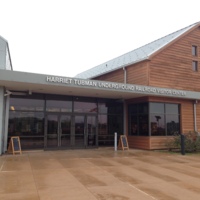
Harriet Tubman Underground Railroad National Historical Park
The Harriet Tubman Underground Railroad National Historical Park was established in 2003, the 100th anniversary of Tubman's death, in rural Dorchester County. In 2017 the Harriet Tubman Underground Railroad Visitor Centre was officially opened. The visitor centre was a collaborative project between the US National Park Service and the Maryland Park Service. The building houses exhibition space, a research library and gift shop. Also on location is a public pavilion and legacy garden.
The design of the site was built around the importance of northward movement in the slave's quest for freedom. The legacy garden stretches out north between the buildings, offering an expansive and hopeful view. The view south is more enclosed and fragmented, reflecting the intolerable existence for those enslaved. The visitor centre houses an exhibition that chronicles the life and accomplishments of Tubman; her birth into slavery, escaping and subsequently returning to free friends and family, her work as a Union spy and her activism after the Civil War. The story is told through a combination of interpretive text, videos, murals, dioramas and her own powerful words.
The park and visitor centre are open seven days a week and are free to the public. The visitor centre also provides further information on the Harriet Tubman Underground Railroad Byway Driving Tour, which has 36 stops throughout the Eastern Shore of Maryland linked to Tubman's life.
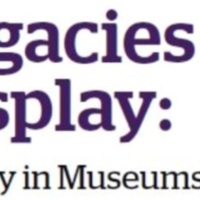
The National Great Blacks in Wax Museum
The National Great Blacks in Wax Museum opened in 1983. It was set up by Drs. Elmer and Joanne Martin as a cultural and educational institution that focusses solely on the study and preservation of African American history. It is a unique organisation as it represents the histories it interprets through the use of life size wax figures, presented in historical settings. The museum has several objectives, including to increase interest in African American history, to use inspiring examples from history to motivate young people to achieve, and to improve race relations by dispelling myths of racial inequalities. The museum attracts around 300,000 visitors annually.
The museum features thirty-five installations of 'great blacks' in a range of scenarios. These cover a large temporal and geographic span, beginning with representations of key figures in pre-slavery Africa, through to dioramas of the space race and modern science. The key focus is on black achievement through all sectors of society, including politics, the military, sport and business.
Many of these installations link to the history of slavery in the United States. They examine the Middle Passage and captivity, plantation life and resistance with graphic displays of the instruments of brutality utilised in the system of enslavement. Others depict key characters in African American journeys to freedom including Henry 'Box' Brown and W.E.B. Dubois. The abolition movement is incorporated into the installations with the characters of Frederick Douglass and Sojourner Truth. The Underground Railroad is also depicted in a display with Harriet Tubman, amongst others. Many of these dioramas also incorporate models of children.
The displays continue to chart the twentieth century, examining the Civil Rights Movement, Black Power, and the Jim Crow Laws. Some of these dioramas illustrate the abhorrent nature of the racial violence that dominated the United States, such as lynching, in graphic detail.
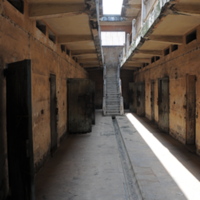
Ussher Fort Museum
The museum is housed within Ussher Fort, one of three European forts built in the Accra region of Ghana during the mid-seventeenth century. Developed by Ghana's Ministry of Tourism, with support and funding from UNESCO, the museum opened in 2007.
The museum aims to highlight the history of the transatlantic slave trade in Ghana. Beginning with the development of the trade in human beings, the museum covers the history through to British abolition.
The collection is varied and includes items once used by both captors and victims. There are weapons, African household items and a model of a slave vessel. The museum also contains paintings of several key abolition figures, including William Wilberforce and Harriet Tubman.
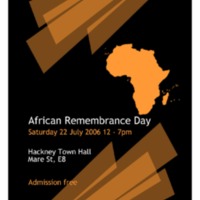
The Ligali organisation, 2007
Ligali is a Pan-African human rights organisation that challenges the misrepresentation of African people, culture and history in the British media. It produced various responses to promote the African perspective of the 2007 bicentenary, including their 'Declaration of Protest to the 2007 Commemoration' expressing dissatisfaction with much of the terminology and focus of the 'official' commemorations. Their particular focus was on the ‘Maafa’, derived from the Kiswahili word meaning ‘great disaster’, and referring to the ongoing impact of enslavement and colonialism for African peoples. The publication ‘Addressing Maafa denial and slavery apologists’ was a guide to promoting the truth about the Maafa from an Africentric position.
‘Maafa: Truth 2007’ is a documentary film directed by the Ligali founder, Toyin Agbetu, and produced by Ligali’s then head of media affairs, emma pierre. The film confronts some of the myths about British slavery, featuring contributions from community activists, project workers, teachers and the African British business community. The film was screened at various events, including African Remembrance Day at Hackney Town Hall in 2006. Ligali’s ‘Freedom Fighter’ stamps were designed by Emma Pierre-Joseph as a response to the Royal Mail’s publication of six stamps to mark the bicentenary. ‘The Walk’ is a documentary record of Toyin Agbetu’s protests at the service at Westminster Abbey to mark the bicentenary on 27 March 2007.
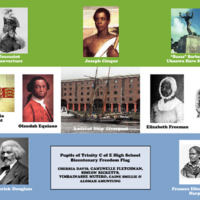
Bicentenary Freedom Flag
The Bicentenary Freedom Flag was displayed alongside an exhibition about Wartime Black History at Manchester Town Hall. The project was a collaboration between staff from Manchester City Council Corporate Services Black Staff Group and pupils of Trinity Church of England School in Manchester. The flag recognised the work, struggles and sacrifices of those who brought the slave trade to an end, and featured images of prominent individuals on the background of the Sierra Leone flag. Those featured on the flag included Toussaint L'Ouverture (General of the Haitian Uprising), the abolitionist Olaudah Equiano, the anti-slavery orator Frederick Douglass, the statue in Barbados of 'Bussa', the unknown slave, guide of the Underground Railroad Harriet Tubman, and Joseph Cinque, leader of the Amistad slave ship revolt. The accompanying exhibition included pupils' articles and creative writing. It also examined the history and role of the West India Regiments, British colonial infantry regiments largely recruited amongst freed slaves from North America and slaves purchased in the West Indies.
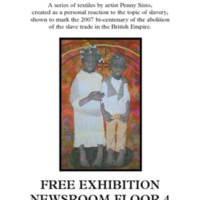
Threads of Strength and Fortitude
Threads of Strength and Fortitude was an exhibition of a series of textiles by artist Penny Sisto, created as a personal response to the bicentenary. The quilts were shipped over from New Albany, Indiana, and exhibited at the Royal Armouries in Leeds. Eight quilts explored the theme of slavery through depictions of servitude, emancipation and the flight to freedom. Pieces on show include 'Slave Ship 1,' which depicts eight enslaved Africans chained by their necks on a slave ship. Another quilt, 'Ran Away', showed a farmer leading Underground Railroad travellers by lantern light. The exhibition was accompanied by an interactive DVD, 'Ordinary People, Extraordinary Courage: Men and Women of the Underground Railroad in the Indiana and Kentucky Borderland'. There was also a series of events, including guest lectures and workshops on the subject of the abolition of slavery aimed at school and community groups. Art-based workshops explored the themes of peaceful resistance.
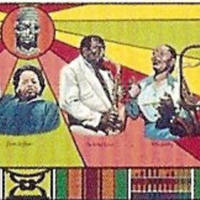
Baltimore Wall of Pride
The Baltimore Wall of Pride stands in the playground at Carey and Cumberland streets in the area of Sandtown-Winchester, Baltimore, Maryland. Painted in 1992 soon after the Rodney King riots of LA, the mural became a site for protest meetings after Freddie Gray was killed in 2015, just blocks away from the mural.Painted by Pontella and Deborah Mason, the mural celebrates the heroes of black history, including Fannie Lou Hamer, James Baldwin, Marcus Garvey, Martin Luther King Jr., Kwame Nkrumah, Charlie Parker, John Coltrane, Langston Hughes, and the antislavery figures Frederick Douglass, Sojourner Truth and Harriet Tubman.
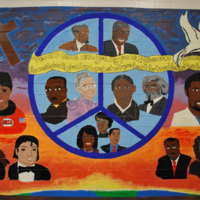
Saint Sabina Mural
In 2011, Chicago-based muralist Lavernon Spivey painted a mural with Howard University students at the Saint Sabina Catholic Church in Chicago’s southside. The mural depicts African American heroes both local and national, past and present, including the antislavery figures Frederick Douglass Harriet Tubman, and also Mae C. Jemison, Barack Obama, Harold Washington, Martin Luther King Jr., Michael Jackson, Michelle Obama, Rosa Parks and Shirley Chisholm. The mural also includes a passage form John 14:27 that reads, “Peace I leave with you, my peace I give unto you not as the world giveth, give I unto you, let not your heart be troubled, neither let it be afraid.”
![Nelson Stevens, Centennial Vision, Tuskegee University Administration Building, AL, 1980 [destroyed].jpg.gif Nelson Stevens, Centennial Vision, Tuskegee University Administration Building, AL, 1980 [destroyed].jpg.gif](https://486312.frmmmguz.asia/files/square_thumbnails/1a0ef8af8ec25559e5c2c7c66502ba40.jpg)
Centennial Vision
In 1980, on the anniversary of the founding of the Tuskegee Institute, AfriCOBRA member Nelson Stevens created a mural to celebrate the occasion. Although Stevens was commonly an exterior mural painter, he created this mural on the inside of the Tuskegee University Administration Building. The mural contains the images of black history figures such as Booker T. Washington (former president of Tuskegee University), General Chappie James and the Tuskegee airmen of World War II, Cinque, Malcolm X, Martin Luther King Jr., and George Washington Carver, as well as the antislavery figures Harriet Tubman, Sojourner Truth and Frederick Douglass. Also included in the image is a phrase made famous by the African scholar John S. Mbiti, “I Am Because We Are.” This mural no longer exists.
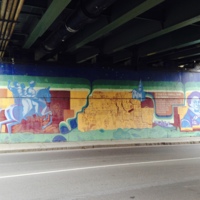
Tubman and Douglass
In 2010 the Brooklyn-based muralist Jonathan Matas created a mural on Green Street in Ithaca under the Aurora Street Bridge. The 30 x 600 foot mural was approved by the Public Arts Commission and depicts Frederick Douglass and Harriet Tubman. “I think it’s a great introduction to our city,” Ithaca Planning and Development Director JoAnn Cornish said. But this was not the general consensus around the mural. The name, 'Comrade Tubman' given to Harriet Tubman on the mural has been a point of controversy for the local community. Tompkins County historian and author Carol Kammen observed: “The word comrade is historically inappropriate and anachronistic."
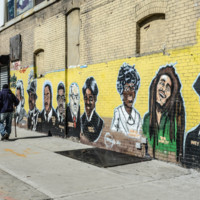
Bed-Stuy Mural
In 2009, the NYC Justice Corps created a mural on Nostrand Avenue and Herkimer Street in Bedford-Stuyvesant, Brooklyn. The NYC Justice Corps was created as part of the city’s strategy to combat poverty and has the mission to “develop the capacity of neighborhoods to address the reintegration challenges of their young adults re-entering from the criminal justice system, and to instil in those young adults a sense of civic responsibility and accountability.”The mural includes the faces of Marcus Garvey, Martin Luther King Jr., Thurgood Marshall, Harriet Tubman, Malcolm X, Shirley Chisholm, Bob Marley and Huey P. Newton, as well as the antislavery figures Harriet Tubman and Frederick Douglass.
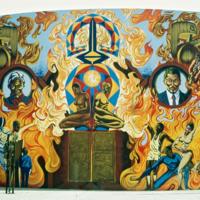
The Fire Next Time I
Dewey Crumpler is an influential black muralist whose work is largely situated in San Francisco. In 1977, after finishing a series of murals at the George Washington High School in San Francisco, the muralist embarked upon two major projects titled The Fire Next Time I and The Fire Next Time II. For the first mural, Crumpler focused on the relationship between African and African American culture. Located at the Joseph Lee Recreation Center in Hunter’s Point-Bayview, the Fire Next Time I deals with education, culture and religion for African Americans. It moves back and forth between the figures of a teacher and a student, Harriet Tubman, Paul Robeson, and two mythical beings in African folk-lore – the Senufo birds.When Crumpler was painting the mural on Oakdale Avenue and Mendell Street in 1977, a local resident approached him and asked about the figures. Upon hearing about Tubman and Robseon, the resident responded: “They don’t live here, man. You should put up a couple of locals like Richard and Edwina. They’re a stone couple.” But a few weeks later, the resident returned and told Crumpler he was right: “black people needed to know more about important leaders so they could have somebody to respect, and besides, Richard and Edwina had broken up.” The mural also faced backlash from a local church group, because of the nude figures at the midpoint.
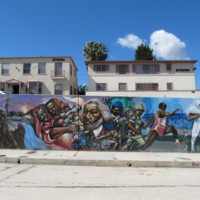
The Crenshaw Wall
In 2000, a graffiti collective called Rocking The Nation (RTN) began The Crenshaw Wall, colloquially known as The Great Wall of Crenshaw. At 7,787 feet long, the mural has become a landmark for the area. The timeline depicts African American history, and features the antislavery figures Frederick Douglass and Harriet Tubman, as well as Marcus Garvey, black soldiers from World War I, II and Vietnam, and Ethiopia’s Emperor Haile Selassie. A shackled slave breaks free from his chains and evolves into an athlete, American footballer and basketball player. Further along the mural are Black Panther Party leaders alongside Martin Luther King Jr., and Malcolm X. The mural starts with a black woman breathing life into the mural and ends with a couple giving birth.“We finally get the chance to paint the Crenshaw Wall, and bring some black awareness to the Crenshaw Wall – to teach the history of our people, to teach our people to be proud, to teach our people love, and where we came from and where we might possibly end up,” explained Enk One of RTN.Over a decade later, the mural requires restoration and protection. RTN are working towards this goal, as well as designating the mural a historical landmark, renaming the block ‘Crenshaw Mural Square’ and developing an app that gives a visual tour of the mural.
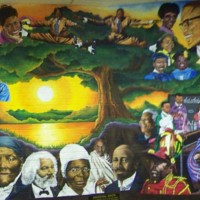
Ancestral Roots
Pontella Mason is one of Baltimore’s unsung visual artists. He has created murals for the Anacostia Community Museum, former President Jimmy Carter, and several other public organisations. His murals depict African American life and the diaspora. In 1999, he created the extensive mural Ancestral Roots, which depicts the antislavery heroes Harriet Tubman, Sojourner Truth, and Frederick Douglass, as well as Martin Luther King Jr., Malcolm X, Muhammad Ali, Notorious B.I.G., Tupac, Shirley Chisholm, and Marcus Garvey.
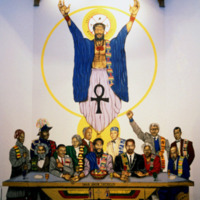
Last Supper
In 1990, muralist Maurice Myron Jenkins created an alternative version of Leonardo da Vinci’s 1494 fresco The Last Supper. The 30 by 19 foot mural depicts the last supper with a black Christ and 12 historical black figures as the prophets. Jenkins chose the Union Temple Baptist Church in Anacostia, Washington D.C. as his canvas because of its role in black history all the way back to its affiliation with Anacostia-resident Frederick Douglass in the 19th century.The mural includes the antislavery figures of Sojourner Truth and Frederick Douglass, as well as Marcus Garvey, Martin Luther King Jr., Rosa Parks, Elijah Muhammad, Malcolm X, Mary McLeod Bethune, Nelson Mandela, Booker T. Washington and W.E.B. Du Bois.
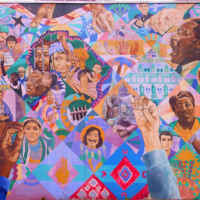
Freedom Quilt Mural
In 1988 David Fichter, with the help of volunteers, painted the Freedom Quilt Mural on the side of the American Friends Service Committee Building in Atlanta, Georgia. The mural was created as part of the Rainbow Coalition events during the 1988 Democratic National Convention. In February 2015 the building, owned by Georgia State University, was torn down – taking the mural with it. The quilted mural is thematically focused on non-violent heroes of history that struggled for justice and peace. It includes the faces of Mubarak Awad, Nelson Mandela, Winnie Mandela, Desmond Tutu, Oscar Romero, Rogoberta Menchu, Leonard Peltier, Andrew Goodman, Fannie Lou Hamer, Daniel Berrigan, Martin Luther King Jr., Rosa Parks, Mahatma Gandhi, and Lucretia Mott. It also includes the antislavery figures of Frederick Douglass and Harriet Tubman. Tubman points towards the North Star. Multi-racial hands stitch the quilt together, joining heroes (both famous and unknown) from all strands of history.
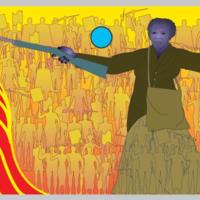
The Dreams of Harriet Tubman
In 2000, muralist Mike Alewitz planned on creating a series of murals about the heroes of the abolitionist movement, titled The Dreams of Harriet Tubman. Alewitz’s goal was to have the Dreams series as a necklace of murals across the state of Maryland with the flagship mural on a major wall in the city of Baltimore. This mural would depict Harriet Tubman, who was also known as Moses. In a pre-circulated plan on Black Radical Congress General News, Alewitz described how the flagship mural would have an army of freedom fighters (Martin Luther King Jr., Malcolm X, Mumia Abu Jamal, Sojourner Truth and Robert Gould) standing behind a musket-wielding Tubman. But the mural stirred up controversy when the group who had planned to display the mural, the Associated Black Charities Inc., decided the piece could be construed as racist and violent. Alewitz was asked to replace the musket but he refused: “I will not disarm Harriet Tubman. I won’t take [the musket] out of her hands.” The lack of a major wall was a setback for the Dreams series and another of the murals, on a wall in Hartford County, was defaced in the summer of 2000 by racist graffiti.
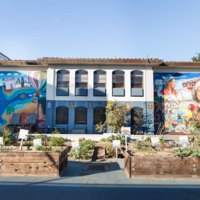
Now and Then
In 1996, the Rafael Elementary School in San Francisco changed its name to Rosa Parks Elementary School, and the San Francisco School Board president commissioned a mural to mark the new name. The mural was a community effort by students from the Art Institute, the Academy of Art and San Francisco State University. It aimed to make children aware of Rosa Parks. Once the mural was finished, Parks herself came to unveil it. Also included on the wall are the antislavery figures Harriet Tubman and Frederick Douglass, as well as Thurgood Marshal and W.E.B. Du Bois.
![Curtis Lewis, African Amalgamation of Ubiquity, 9980 Gratiot Avenue, Detroit, Michigan, 1985 [destroyed in 2013].jpg Curtis Lewis, African Amalgamation of Ubiquity, 9980 Gratiot Avenue, Detroit, Michigan, 1985 [destroyed in 2013].jpg](https://486312.frmmmguz.asia/files/square_thumbnails/3ac63b31ad894031e7c74b99651ace4a.jpg)
African Amalgamation of Ubiquity
In 1985, muralist Curtis Lewis created a mural on the side of a drug rehabilitation centre on Gratiot Avenue, Detroit, Michigan. The building belonged to Operation Get Down and included the antislavery figures Frederick Douglass and Harriet Tubman, as well as Malcolm X, Mary McLeod Bethune, Jesse Jackson, Thurgood Marshall, Martin Luther King Jr., W.E.B. Du Bois, Booker T. Washington, Ida B. Wells, Marcus Garvey and Nelson Mandela, alongisde Egyptian, Nubian and pharaoh figures. The man who breaks free of his chains in the centre of the mural holds a sign that reads, “Behold my people, arise, stand strong and proud, for ye come from pharaohs, emperors, kings and queens.” The mural was destroyed in 2013.